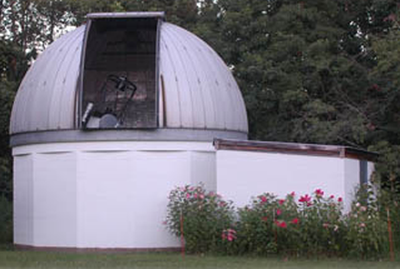Astrophysics
Faculty and students in the Department of Physics and Astronomy pursue research in extragalactic, galactic, and stellar astrophysics, laboratory astrophysics, and instrumentation development.
Read More ...Faculty and students in the Department of Physics and Astronomy pursue research in extragalactic, galactic, and stellar astrophysics, laboratory astrophysics, and instrumentation development.  Areas of observational research include the use of quasar absorption line systems as tracers of large scale structure, the large-scale distribution of galaxies in large quasar groups, extended emission regions around proto-galaxies and the evolution of the elements in the Universe since the Big Bang. The composition and structure of the interstellar medium in the Milky Way as well as external galaxies are studied using multi-wavelength approaches from the X-rays to the radio.Multi-wavelength imaging and spectroscopic studies of proto-planetary disks are being made to determine the nature and evolution of planetary formation around other stars. Laboratory and theoretical physics are being applied to reveal the structure and evolution of brown dwarf stars. Finally, advanced technologies in optical and computer sciences are opening windows in the near infrared for high dynamic range adaptive time-resolved imaging.
Areas of observational research include the use of quasar absorption line systems as tracers of large scale structure, the large-scale distribution of galaxies in large quasar groups, extended emission regions around proto-galaxies and the evolution of the elements in the Universe since the Big Bang. The composition and structure of the interstellar medium in the Milky Way as well as external galaxies are studied using multi-wavelength approaches from the X-rays to the radio.Multi-wavelength imaging and spectroscopic studies of proto-planetary disks are being made to determine the nature and evolution of planetary formation around other stars. Laboratory and theoretical physics are being applied to reveal the structure and evolution of brown dwarf stars. Finally, advanced technologies in optical and computer sciences are opening windows in the near infrared for high dynamic range adaptive time-resolved imaging.
We utilize both ground and space-based facilities such as the telescopes at Kitt Peak National Observatory, Apache Point Observatory, the Hubble Space Telescope, and the Gemini Observatories to pursue both galactic and extragalactic observational studies. The department also operates Moore Observatory, near Louisville, Kentucky, and in collaboration with the University of Southern Queensland, Mt. Kent Observatory near Toowoomba, Australia. A 0.6-meter technically advanced research telescope at Moore Observatory, is used for a training and research programs in instrumentation and stellar astrophysics. The observatories are home to a pair of remotely operable robotic 0.5-meter telescopes that provide nearly continuous coverage of the entire sky and permit a rapid response to transient events such as gamma ray bursts, supernovae, and exo-planet transits. Through Internet2, these robotic telescopes deliver hands-on astronomy education to undergraduate students on campus, and to schools throughout the state.
Research on the dynamics and thermodynamics of planetary atmospheres is carried out using the EPIC Atmospheric model, funded by NASA and NSF, which is a general circulation model designed for planetary applications. EPIC stands for "Explicit Planetary Isentropic Coordinate" and is the leading model for the atmospheres of the gas giants Jupiter, Saturn, Uranus, and Neptune. The model can also be used to simulate terrestial-class atmospheres. This work is carried out at the Comparative Planetology Laboratory.
Faculty
- Timothy Dowling, Ph.D. (California Institute of Technology)
- Benne Holwerda, Ph.D. (University of Groningen, The Netherlands)
- John F. Kielkopf, Ph.D. (The John Hopkins University)
- James T. Lauroesch, Ph.D. (University of Chicago)
- Gerard M. Williger, Ph.D. (Cambridge University)
Representative Publications
- Study of the K-H_2 quasi-molecular line satellite in the potassium resonance line, N. F. Allard, F. Spiegelman, and J. F. Kielkopf, Astronomy and Astrophysics, 465, 1085-1091 (2007).
- Impact broadening of alkali lines in brown dwarfs, N. F. Allard, J. F. Kielkopf, and F. Allard, European Physical Journal D -- Atomic, Molecular and Optical Physics, 44, 507-514 (2007).
- A MIKE + UVES survey of sub-damped Lyman α systems at z < 1.5, Meiring, Joseph D., Lauroesch, James T., Kulkarni, Varsha P., Péroux, Celine, Khare, Pushpa & York, Donald G. 2009, MNRAS, 397, 2037
- SOAR imaging of sub-damped Lyman α systems at z < 1, Meiring, Joseph D., Lauroesch, James T., Haberzettl, Lutz, Kulkarni, Varsha P., Péroux, Céline, Khare, Pushpa & York, Donald G. 2011, MNRAS, 410, 2516M
- The Clowes-Campusano Large Quasar Group Survey. I. GALEX Selected Sample of Lyman Break Galaxies at z ~ 1, Haberzettl, L., Williger, G. M., Lauroesch, J. T., Haines, C. P., Valls-Gabaud, D., Harris, K. A., Koekemoer, A. M., Loveday, J., Campusano, L. E., Clowes, R. G., Davé, R., Graham, M. J. & Söchting, I. K., 2009, ApJ, 702, 506
- A Link Between Gas-Rich Protoplanetary Disks and Gas-Poor Debris Disks, Collins, K.A., Grady, C.A., Hamaguchi, K., Wisniewski, J.P., Brittain, S., Sitko, M., Carpenter, W.J., Williams, J.P., Matthews, G.S., Williger, G.M., van Boekel, R., Carmona, A., van den Ancker, M.E., Meeus, G., Chen, X.P., Petre, R., Woodgate, B.E., Henning, Th. ApJ, 697, 557 (2009).
- The Connection between a Lyman Limit System, a very strong OVI Absorber, and Galaxies at z ~ 0.203, Lehner, N., Prochaska, J.X., Kobulnicky, H.A., Cooksey, K.L., Howk, J.C., Williger, G.M., Cales, S.L., ApJ, 694, 734 (2009).
